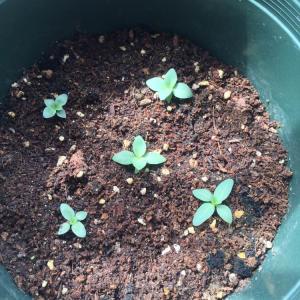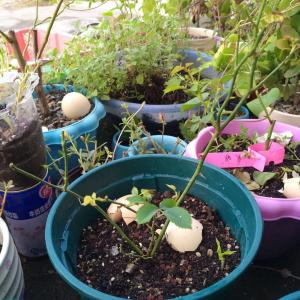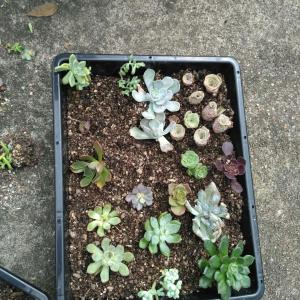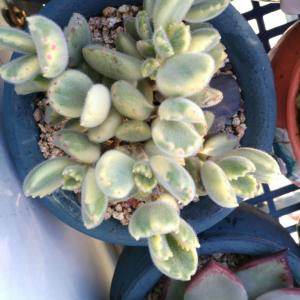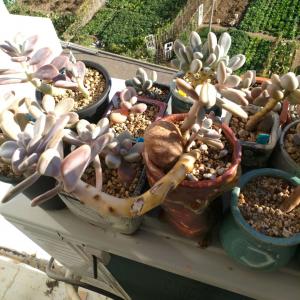文章
Dummer. ゛☀
2017年10月02日

False Peyote (Ariocarpus fissuratus) is a small cactus that grows only a few centimeters in height and about 4-6 inches in diameter. Its nodes end in pointed triangles, giving the cactus a star-like appearance. The flowers are pink-violet in color. These little cacti are often mistaken for rocks in the stony desert in which they grow and are therefore difficult to find. Ariocarpus fissuratus is found only in New Mexico, northern Mexico and southwest Texas.
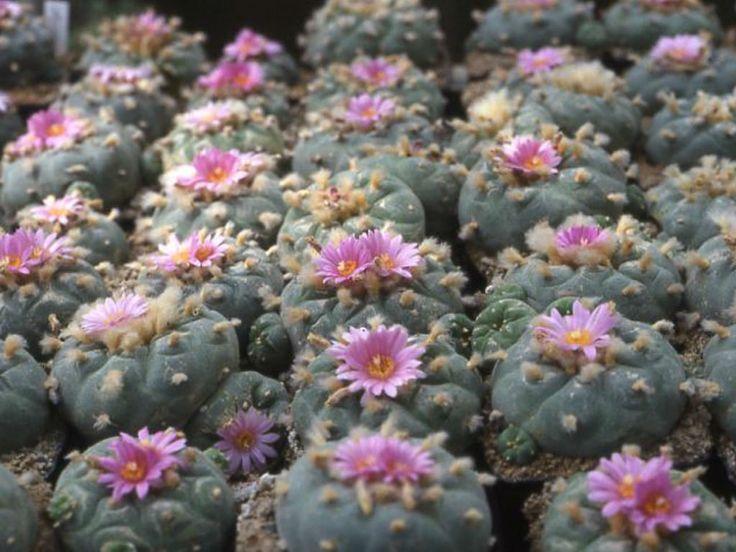
Traditional Uses
Ariocarpus fissuratus is usually referred to as false or dangerous Peyote, and has been known in the Americas since pre-Columbian times. This cactus was very possibly used as a Peyote substitute when Peyote was unavailable. The Huichol strongly warn against consuming Ariocarpus fissuratus, and associate it with dark sorcery. They believe that those individuals who do not properly purify themselves at the start of the Peyote hunt pilgrimage by admitting all of their sexual encounters outside of marriage may mistake Ariocarpus fissuratus for real Peyote, the consumption of which will result in a deliriant-hallucinogenic state. The Tarahumara, meanwhile, consider they to be even more powerful than Peyote.
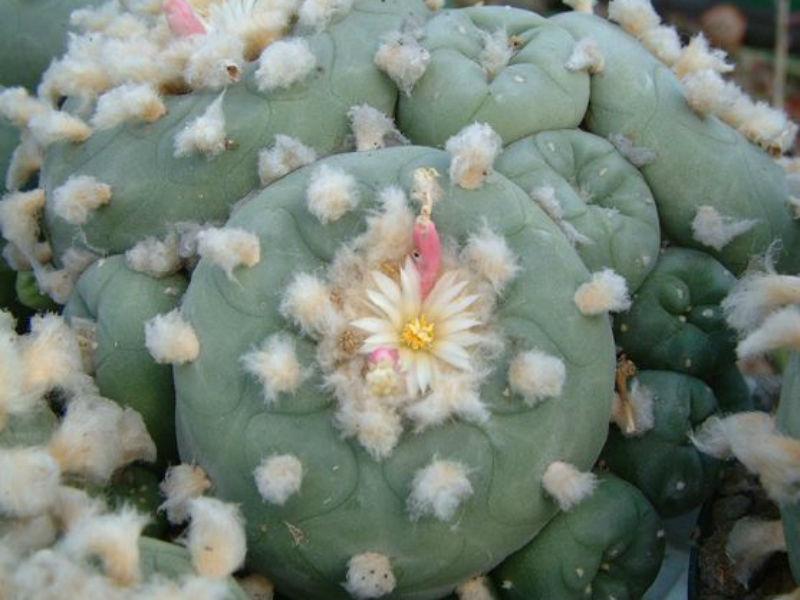
Medicinal Uses
Ariocarpus fissuratus, and the related Ariocarpus retusus may have been used to treat malaria by some peoples in Mexico. The related Ariocarpus kotschoubeyanus is used as an external medicine to treat wounds. Certain reports of the consumption of Ariocarpus fissuratus also mention that it has strong narcotic pain-killing properties.

Traditional Uses
Ariocarpus fissuratus is usually referred to as false or dangerous Peyote, and has been known in the Americas since pre-Columbian times. This cactus was very possibly used as a Peyote substitute when Peyote was unavailable. The Huichol strongly warn against consuming Ariocarpus fissuratus, and associate it with dark sorcery. They believe that those individuals who do not properly purify themselves at the start of the Peyote hunt pilgrimage by admitting all of their sexual encounters outside of marriage may mistake Ariocarpus fissuratus for real Peyote, the consumption of which will result in a deliriant-hallucinogenic state. The Tarahumara, meanwhile, consider they to be even more powerful than Peyote.

Medicinal Uses
Ariocarpus fissuratus, and the related Ariocarpus retusus may have been used to treat malaria by some peoples in Mexico. The related Ariocarpus kotschoubeyanus is used as an external medicine to treat wounds. Certain reports of the consumption of Ariocarpus fissuratus also mention that it has strong narcotic pain-killing properties.
0
1
成长记
Koala小熊
2017年10月01日

養了4個月,熊童子長得很棒,上星期替它修剪了一下,然後開始扦插繁殖,希望也一樣可以長得很好(^^)


1
0
Koala小熊:@lrgarden :謝謝你(^^)
lrgarden:好可爱
文章
Miss Chen
2017年10月01日

La Acacia Bola es un árbol que pertenece a la familia Leguminosas, género Robinia, especie pseudoacacia, variedad Umbraculifera.
Sus principales características son:
Altura: de 4 a 6 metros.
Diámetro: de 3 a 5 metros.
Crecimiento: rápido.
Suelo: se adapta a todos los tipos.
Temperatura: resiste bien el frío.
Transplante: muy buena tolerancia.
Uso: ornamental.
Origen: Estados Unidos.
La Acacia Bola es un pequeño árbol de follaje caduco, copa compacta y globosa.
Las hojas son de color verde claro y las ramas no presentan espinas. Su principal atractivo radica en la copa redondeada y el follaje denso.
Éste árbol rústico crece en todo tipo de suelos, auqnue prefiere los bien drenados, y presenta una buena tolerancia al frío.
La Acacia Bola se cultiva como ornamental. Crece por injertos sobre pie franco o por estacas.
Suele utilizarse en el arbolado de calles y jardines pequeños.




Sus principales características son:
Altura: de 4 a 6 metros.
Diámetro: de 3 a 5 metros.
Crecimiento: rápido.
Suelo: se adapta a todos los tipos.
Temperatura: resiste bien el frío.
Transplante: muy buena tolerancia.
Uso: ornamental.
Origen: Estados Unidos.
La Acacia Bola es un pequeño árbol de follaje caduco, copa compacta y globosa.
Las hojas son de color verde claro y las ramas no presentan espinas. Su principal atractivo radica en la copa redondeada y el follaje denso.
Éste árbol rústico crece en todo tipo de suelos, auqnue prefiere los bien drenados, y presenta una buena tolerancia al frío.
La Acacia Bola se cultiva como ornamental. Crece por injertos sobre pie franco o por estacas.
Suele utilizarse en el arbolado de calles y jardines pequeños.




0
1
文章
Miss Chen
2017年10月01日

La Casuarina es un árbol que pertenece a la familia Casuarináceas, género Casuarina, especie cunninghamiana.

Sus principales características son:
Altura: de 20 a35 metros.
Diámetro: de 4 a 7 metros.
Crecimiento: rápido.
Suelo: se adapta a todos los tipos.
Temperatura: resiste bien el frío.
Transplante: mala tolarancia.
Usos: ornamental y forestal.
Origen: Australia.
Es un árbol muy rústico, de gran altura y rápido crecimiento.

Sus hojas, perennes, filiformes y de color verde oscuro, recuerdan el follaje de las coníferas. La copa es angostamente piramidal y el tronco, gris oscuro.
Produce frutos que forman pequeñas piñas o conos, los que maduran al final del verano. Es muy resistente a climas adversos y se adapta a todo tipo de suelos; presenta una alta tolerancia a los anegadizos o los terrenos calcáreos y secos. Además, resiste bien la acción de los vientos marinos.
Es un árbol delicado para el transplante; éste fracasa si se dañan las raíces, que suelen ser largas.
Su uso es ornamental y forestal. Se reproduce fácilmente por semillas. Suele plantarse como cortina rompevientos o pantalla, en hileras dobles o simples. No es recomendable para jardines pequeños.
Es aconsejable plantarlo en zonas marginales donde ningún otro árbol propera o para crear microclimas en esas zonas.

Sus principales características son:
Altura: de 20 a35 metros.
Diámetro: de 4 a 7 metros.
Crecimiento: rápido.
Suelo: se adapta a todos los tipos.
Temperatura: resiste bien el frío.
Transplante: mala tolarancia.
Usos: ornamental y forestal.
Origen: Australia.
Es un árbol muy rústico, de gran altura y rápido crecimiento.

Sus hojas, perennes, filiformes y de color verde oscuro, recuerdan el follaje de las coníferas. La copa es angostamente piramidal y el tronco, gris oscuro.
Produce frutos que forman pequeñas piñas o conos, los que maduran al final del verano. Es muy resistente a climas adversos y se adapta a todo tipo de suelos; presenta una alta tolerancia a los anegadizos o los terrenos calcáreos y secos. Además, resiste bien la acción de los vientos marinos.
Es un árbol delicado para el transplante; éste fracasa si se dañan las raíces, que suelen ser largas.
Su uso es ornamental y forestal. Se reproduce fácilmente por semillas. Suele plantarse como cortina rompevientos o pantalla, en hileras dobles o simples. No es recomendable para jardines pequeños.
Es aconsejable plantarlo en zonas marginales donde ningún otro árbol propera o para crear microclimas en esas zonas.
0
0
文章
Dummer. ゛☀
2017年10月01日

False Peyote (Ariocarpus fissuratus) is a small cactus that grows only a few centimeters in height and about 4-6 inches in diameter. Its nodes end in pointed triangles, giving the cactus a star-like appearance. The flowers are pink-violet in color. These little cacti are often mistaken for rocks in the stony desert in which they grow and are therefore difficult to find. Ariocarpus fissuratus is found only in New Mexico, northern Mexico and southwest Texas.
Traditional Uses
Ariocarpus fissuratus is usually referred to as false or dangerous Peyote, and has been known in the Americas since pre-Columbian times. This cactus was very possibly used as a Peyote substitute when Peyote was unavailable. The Huichol strongly warn against consuming Ariocarpus fissuratus, and associate it with dark sorcery. They believe that those individuals who do not properly purify themselves at the start of the Peyote hunt pilgrimage by admitting all of their sexual encounters outside of marriage may mistake Ariocarpus fissuratus for real Peyote, the consumption of which will result in a deliriant-hallucinogenic state. The Tarahumara, meanwhile, consider they to be even more powerful than Peyote.
Medicinal Uses
Ariocarpus fissuratus, and the related Ariocarpus retusus may have been used to treat malaria by some peoples in Mexico. The related Ariocarpus kotschoubeyanus is used as an external medicine to treat wounds. Certain reports of the consumption of Ariocarpus fissuratus also mention that it has strong narcotic pain-killing properties.

Traditional Uses
Ariocarpus fissuratus is usually referred to as false or dangerous Peyote, and has been known in the Americas since pre-Columbian times. This cactus was very possibly used as a Peyote substitute when Peyote was unavailable. The Huichol strongly warn against consuming Ariocarpus fissuratus, and associate it with dark sorcery. They believe that those individuals who do not properly purify themselves at the start of the Peyote hunt pilgrimage by admitting all of their sexual encounters outside of marriage may mistake Ariocarpus fissuratus for real Peyote, the consumption of which will result in a deliriant-hallucinogenic state. The Tarahumara, meanwhile, consider they to be even more powerful than Peyote.

Medicinal Uses
Ariocarpus fissuratus, and the related Ariocarpus retusus may have been used to treat malaria by some peoples in Mexico. The related Ariocarpus kotschoubeyanus is used as an external medicine to treat wounds. Certain reports of the consumption of Ariocarpus fissuratus also mention that it has strong narcotic pain-killing properties.

0
0
文章
Miss Chen
2017年09月29日

Tulips (Tulipa spp.) poking their heads out of the soil is one of the first signs that spring has arrived, and the brightly colored blooms don't disappoint in the weeks that follow. Hardy in U.S. Department of Agriculture plant hardiness zones 4 through 10, most tulips are perennial, and they'll bloom again next spring if you take proper care of them once they're done blooming this year.

As Blooms Fade
Once the tulip blooms have started to wilt and droop, gently pluck the remaining petals from the stem. If you prefer, cut off the dead flowers, as well as 1 to 2 inches of the stem. Don't, however, pull or snip off the plants' leaves. Allow the leaves to die back on their own, because even though the flower is gone for the year, the roots of the plant still rely on photosynthesis from the leaves to feed the plant. Deadheading the blooms prevents the plant from developing seeds and directs the plant's energy back into the bulb. To prevent disease, always use disinfected pruning tools when cutting any portion of the tulip.
After the Stems Turn Yellow
If you don't like the way the dying leaves and stems look, plant other flowers or foliage around the tulips to disguise the unsightliness. After the leaves have turned yellow and died back on their own, gently remove them from the stem. If the stems have wilted or turned yellow or brown, snip them off at ground level. Don't be tempted to do this too soon, however, or it could inhibit the tulips from returning next year. In cooler areas that experience frost and snow, cover the tulip bed with 2 to 4 inches of organic mulch like straw to protect the bulbs over winter. Use the same amount of mulch in warmer zones to preserve moisture in the soil.
Water Properly
As long as the stems of the tulips are green, you need to water them regularly. Until the stem dies, the bulb is storing up energy for the winter and water is necessary for this process. While there isn't a specific guideline regarding how much to water the tulips once they've bloomed, it's a good idea to give them a thorough watering every few days, especially if your area is experiencing a dry spell and make sure to continue watering during dry weather conditions throughout fall. Apply enough water to saturate the soil to a depth of approximately 6 inches to reach the tulip roots.

Divide and Fertilize
Older plants might need to be divided after they bloom to encourage them to return the next spring and to alleviate overcrowding that creates smaller bloom size. In warm areas of USDA zones 8 through 10, tulip bulbs require lifting and storing for six to eight weeks in the refrigerator inside a paper bag. Don't store the bulbs next to ripening fruit where the ethylene gas destroys the flower bud developing inside the bulb. When lifting and replanting, dig up the older bulbs and remove the largest "daughter" bulb. Replant each daughter 6 to 8 inches deep and spacing each bulb 5 inches apart, keeping in mind that tulips thrive in full sun. Fertilizing is usually recommended while the tulips are blooming, but you should also plan to fertilize if you divide the bulbs after they bloom. When blooming starts to occur, incorporate 2 pounds of 5-10-5 or 5-10-10 fertilizer per 100 square feet into the soil. Incorporate the fertilizer into the top inch of soil and wash it off any portion of the tulip it touches. The same type of balanced fertilizer can be applied right after you divide and replant the bulbs. When adding fertilizer to the planting hole, be sure to cover the fertilizer with approximately 1 inch of soil and do not allow the bulb to have direct contact with the fertilizer so the bulb isn't damaged or burned.

As Blooms Fade
Once the tulip blooms have started to wilt and droop, gently pluck the remaining petals from the stem. If you prefer, cut off the dead flowers, as well as 1 to 2 inches of the stem. Don't, however, pull or snip off the plants' leaves. Allow the leaves to die back on their own, because even though the flower is gone for the year, the roots of the plant still rely on photosynthesis from the leaves to feed the plant. Deadheading the blooms prevents the plant from developing seeds and directs the plant's energy back into the bulb. To prevent disease, always use disinfected pruning tools when cutting any portion of the tulip.
After the Stems Turn Yellow
If you don't like the way the dying leaves and stems look, plant other flowers or foliage around the tulips to disguise the unsightliness. After the leaves have turned yellow and died back on their own, gently remove them from the stem. If the stems have wilted or turned yellow or brown, snip them off at ground level. Don't be tempted to do this too soon, however, or it could inhibit the tulips from returning next year. In cooler areas that experience frost and snow, cover the tulip bed with 2 to 4 inches of organic mulch like straw to protect the bulbs over winter. Use the same amount of mulch in warmer zones to preserve moisture in the soil.
Water Properly
As long as the stems of the tulips are green, you need to water them regularly. Until the stem dies, the bulb is storing up energy for the winter and water is necessary for this process. While there isn't a specific guideline regarding how much to water the tulips once they've bloomed, it's a good idea to give them a thorough watering every few days, especially if your area is experiencing a dry spell and make sure to continue watering during dry weather conditions throughout fall. Apply enough water to saturate the soil to a depth of approximately 6 inches to reach the tulip roots.

Divide and Fertilize
Older plants might need to be divided after they bloom to encourage them to return the next spring and to alleviate overcrowding that creates smaller bloom size. In warm areas of USDA zones 8 through 10, tulip bulbs require lifting and storing for six to eight weeks in the refrigerator inside a paper bag. Don't store the bulbs next to ripening fruit where the ethylene gas destroys the flower bud developing inside the bulb. When lifting and replanting, dig up the older bulbs and remove the largest "daughter" bulb. Replant each daughter 6 to 8 inches deep and spacing each bulb 5 inches apart, keeping in mind that tulips thrive in full sun. Fertilizing is usually recommended while the tulips are blooming, but you should also plan to fertilize if you divide the bulbs after they bloom. When blooming starts to occur, incorporate 2 pounds of 5-10-5 or 5-10-10 fertilizer per 100 square feet into the soil. Incorporate the fertilizer into the top inch of soil and wash it off any portion of the tulip it touches. The same type of balanced fertilizer can be applied right after you divide and replant the bulbs. When adding fertilizer to the planting hole, be sure to cover the fertilizer with approximately 1 inch of soil and do not allow the bulb to have direct contact with the fertilizer so the bulb isn't damaged or burned.
0
0
文章
我说肉肉你说萌!
2017年09月28日
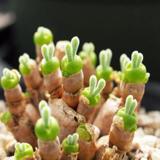
一般来说选用的盆,要比多肉的冠幅(直径),大个1-2cm,或1/3-1/4,更利于多肉长大,或群生。盆的高度可比盆宽度略高,或略矮(瓦苇系的盆可高点),通常不建议细筒高盆,不利于空气流通,也不利于把握浇水的分量。
#多肉 种下后,盆留有一定间隙,方便多肉生长,也方便自己浇水。






如果植株本身是生长较快的品种,如仙女之舞、玉蝶,选择的盆可以再大点,如植株的2-3倍宽,盆太大,浇水的时机会较难把握。不清楚长得快不快,则参考上一点,可以等长大了,再换盆。
盆过大的情况下,浇水要多用点心。


如果,不想多肉长太大,保持多肉娇小的体型,则可以用跟多肉大小差不多,或比多肉还小的盆,以达到控型的目的。
已经半木质化的老桩也没必要换更大的盆,已经长不动了。


#多肉 种下后,盆留有一定间隙,方便多肉生长,也方便自己浇水。






如果植株本身是生长较快的品种,如仙女之舞、玉蝶,选择的盆可以再大点,如植株的2-3倍宽,盆太大,浇水的时机会较难把握。不清楚长得快不快,则参考上一点,可以等长大了,再换盆。
盆过大的情况下,浇水要多用点心。


如果,不想多肉长太大,保持多肉娇小的体型,则可以用跟多肉大小差不多,或比多肉还小的盆,以达到控型的目的。
已经半木质化的老桩也没必要换更大的盆,已经长不动了。


5
3
文章
Miss Chen
2017年09月28日

La revista francesa de jardinería, “Les 4 Saisons du jardin bio”, lanzó este reto a sus lectores, que cultivaran patatas sin enterrarlas bajo tierra. Se exigió cumplir un protocolo en el que se cultivaron dos parcelas con patatas, una con las patatas sin enterrar, sólo recubiertas con un acolchado de paja y fibras vegetales y otra de control con las patatas cultivadas en tierra. Ambas parcelas debían recibir la misma fertilización, de 2 a 3 kg. de compost por metro cuadrado.
El cultivo en la parcela de control se hizo como es costumbre y cuando las plantas tenían unos 15 cm de altura se recalzaron con tierra. En la otra parcela las patatas se colocaron sobre el suelo con la misma separación con que habitualmente se siembra la patata, se recubrieron las patatas con una capa de mantillo de 5 a 8 cm, formado por paja, hojas y diversos restos de fibras vegetales. A la brotación de las plantas se añadió otra capa de mantillo de unos 5 cm. Tras la cosecha se registraron rigurosamente el número de tubérculos por planta, el peso de los mismos y el número de patatas enverdecidas. Se testaron diversas variedades de patatas.

Las patatas cultivadas en mantillo sufrieron un retraso en su desarrollo de hasta dos semanas respecto de las cultivadas en tierra. Seguramente porque la capacidad de retención del calor del mantillos es menor que la de la tierra. Una gran ventaja que ofreció el mantillo fue la escasa proliferación de malas hierbas, incapaces de crecer sobre ese soporte. En cambio puede haber más problemas con las babosas y los caracoles y también con los ratones. El tubérculo está más expuesto cuando sólo está recubierto por una leve capa de fibras vegetales. Otra ventaja tras la cosecha es la limpieza del tubérculo cultivado en mulching, lo recogemos totalmente limpio al no llevar tierra adherida. También son mucho más fáciles de cosechar, no hace falta herramientas con lo que nos evitamos dañar los tubérculos accidentalmente. La necesidad de riego también fue inferior en el caso de la patata cultivada en mantillo.

Tras la prueba se sacaron algunas conclusiones que pueden mejorar la técnica, así se consideró conveniente trabajar la tierra antes del cultivo para que esté más suelta e introducir los tubérculos unos centímetros en el suelo en vez de dejarlos simplemente sobre él. Evitar poner una capa demasiado gruesa de acolchado sobre los tubérculos desde el principio, es mejor poner una capa más fina y esperar a la aparición de las plántulas para reforzar con una nueva capa de acolchado. Lo ideal es aprovechar para esta capa de acolchado el material que nos proporcione nuestro propio jardín, hojas, ramitas, paja, hierbas, etc… triturándolo si es necesario. También se pueden añadir hojas de consuelda que son ricas en potasio.
El cultivo en la parcela de control se hizo como es costumbre y cuando las plantas tenían unos 15 cm de altura se recalzaron con tierra. En la otra parcela las patatas se colocaron sobre el suelo con la misma separación con que habitualmente se siembra la patata, se recubrieron las patatas con una capa de mantillo de 5 a 8 cm, formado por paja, hojas y diversos restos de fibras vegetales. A la brotación de las plantas se añadió otra capa de mantillo de unos 5 cm. Tras la cosecha se registraron rigurosamente el número de tubérculos por planta, el peso de los mismos y el número de patatas enverdecidas. Se testaron diversas variedades de patatas.

Las patatas cultivadas en mantillo sufrieron un retraso en su desarrollo de hasta dos semanas respecto de las cultivadas en tierra. Seguramente porque la capacidad de retención del calor del mantillos es menor que la de la tierra. Una gran ventaja que ofreció el mantillo fue la escasa proliferación de malas hierbas, incapaces de crecer sobre ese soporte. En cambio puede haber más problemas con las babosas y los caracoles y también con los ratones. El tubérculo está más expuesto cuando sólo está recubierto por una leve capa de fibras vegetales. Otra ventaja tras la cosecha es la limpieza del tubérculo cultivado en mulching, lo recogemos totalmente limpio al no llevar tierra adherida. También son mucho más fáciles de cosechar, no hace falta herramientas con lo que nos evitamos dañar los tubérculos accidentalmente. La necesidad de riego también fue inferior en el caso de la patata cultivada en mantillo.

Tras la prueba se sacaron algunas conclusiones que pueden mejorar la técnica, así se consideró conveniente trabajar la tierra antes del cultivo para que esté más suelta e introducir los tubérculos unos centímetros en el suelo en vez de dejarlos simplemente sobre él. Evitar poner una capa demasiado gruesa de acolchado sobre los tubérculos desde el principio, es mejor poner una capa más fina y esperar a la aparición de las plántulas para reforzar con una nueva capa de acolchado. Lo ideal es aprovechar para esta capa de acolchado el material que nos proporcione nuestro propio jardín, hojas, ramitas, paja, hierbas, etc… triturándolo si es necesario. También se pueden añadir hojas de consuelda que son ricas en potasio.
0
0



